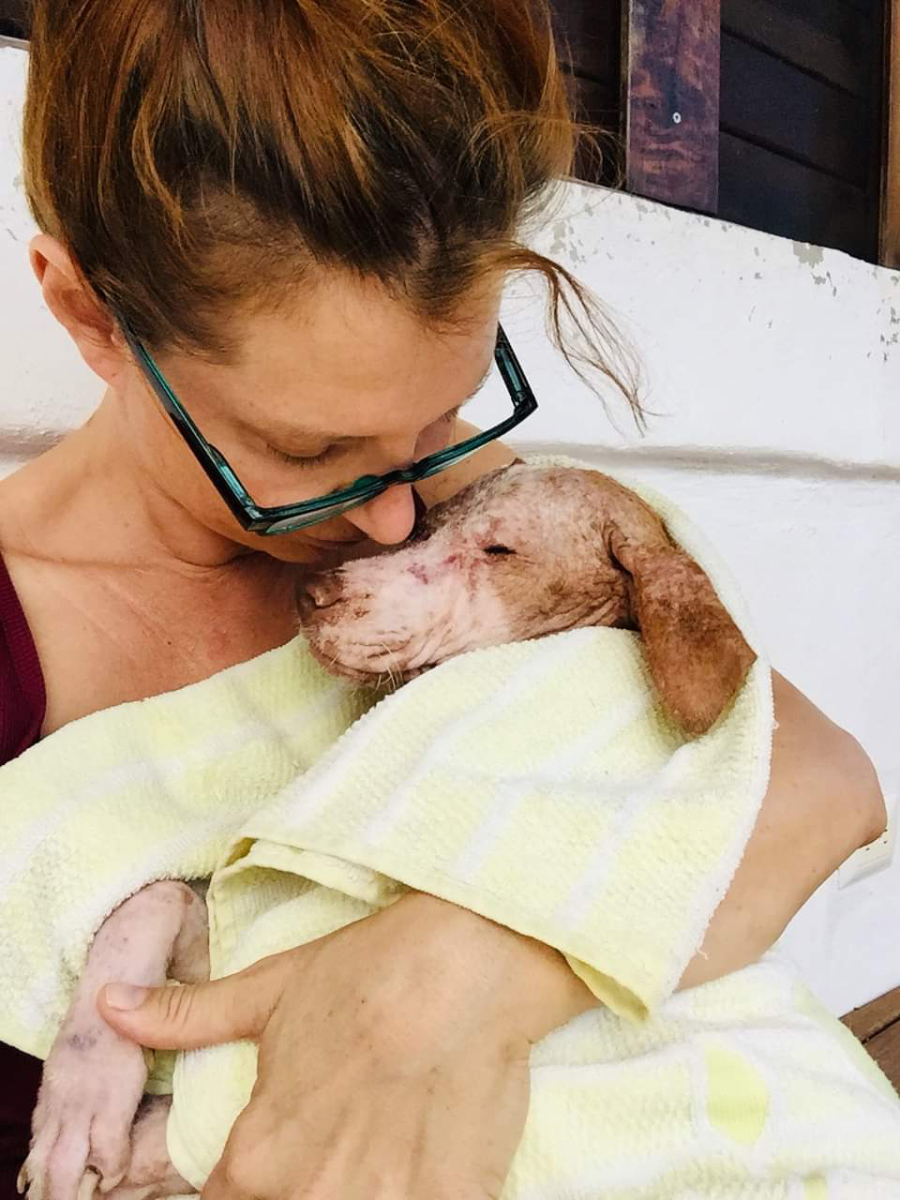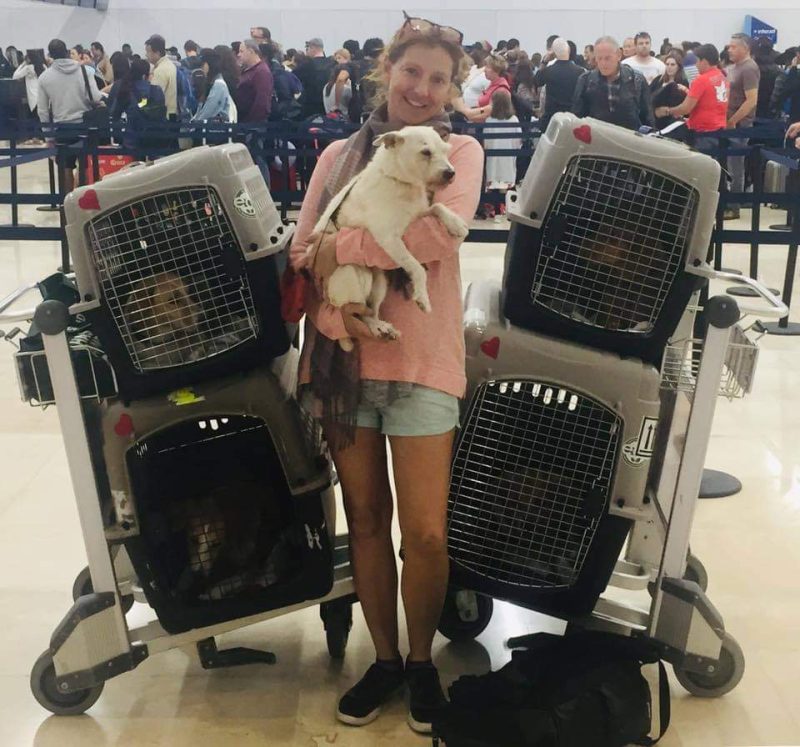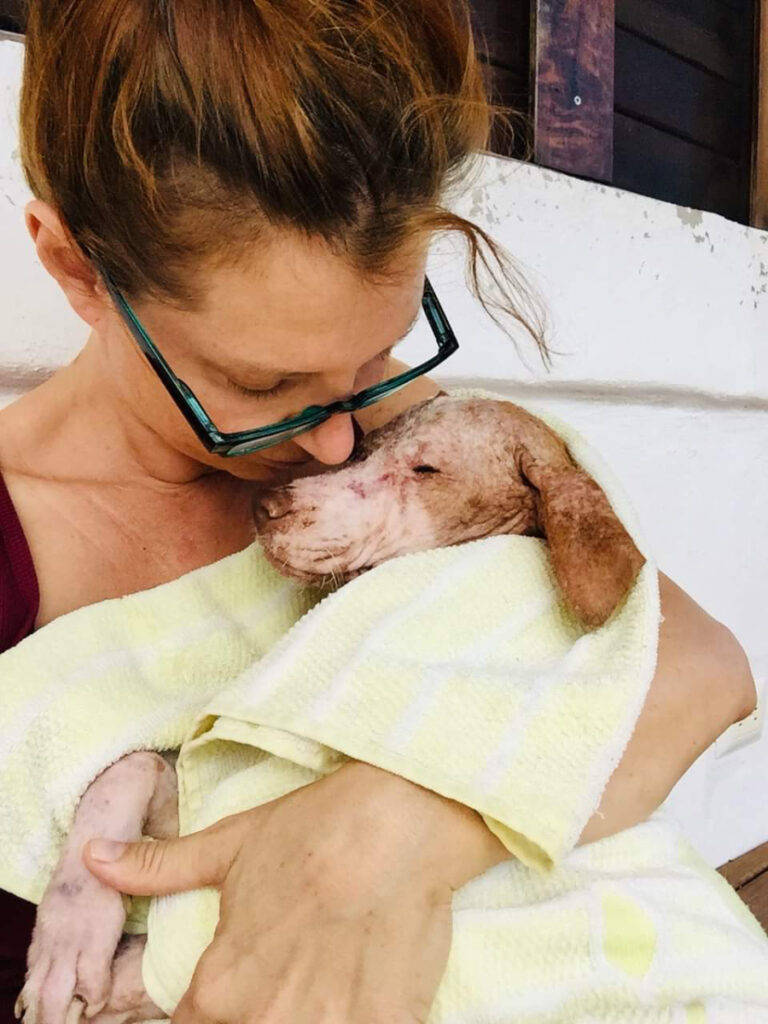The post Beach Dog Rescue Surpasses 7,000 Spay/Neuter Milestone in Yucatan, Mexico by Nicole Cosgrove appeared first on Dogster. Copying over entire articles infringes on copyright laws. You may not be aware of it, but all of these articles were assigned, contracted and paid for, so they aren’t considered public domain. However, we appreciate that you like the article and would love it if you continued sharing just the first paragraph of an article, then linking out to the rest of the piece on Dogster.com.
In the heart of Yucatan, Mexico—about five hours from Cancun—a small farm has become a haven for dogs awaiting a new life. Beach Dog Rescue, run by Heather and Gil Johnson, is more than a typical shelter; it’s a sanctuary. Here, dogs stay until they’re ready to journey to trusted rescue partners in New York City and Canada, where they will eventually find their furever families. In Mexico, where over 16 million dogs live on the streets,1 Beach Dog Rescue is helping address the crisis one dog at a time.
The mission is clear for Beach Dog Rescue: spaying and neutering are crucial to ending pet homelessness. “While we very much love to rescue individual animals, we cannot rescue our way out of this crisis,” Heather Johnson, one of Beach Dog Rescue’s founders explained.
Many of the animals they work with are street dogs or pets whose owners can’t afford vet costs. According to the Humane Society, an unspayed female dog and her offspring can produce over 60,000 puppies in just over six years; a female cat and her offspring, even more.
The journey for Heather and Gil began in 2016 when they relocated from New Jersey to Mahahual, a fishing village in Mexico. As they drove 3,500 miles through the country, they were struck by the sight of homeless, starving dogs. One particularly haunting encounter involved a skeletal dog sniffing around their construction site in Mahahual, hoping for scraps. Heather named him Pinto, and although he didn’t survive long, Pinto’s memory fuels their mission. Every rescue they undertake is in his honor.
How Beach Dog Rescue Began

After being spoiled at an all-inclusive resort in Playa del Carmen in 2003, Heather and Gil thought it would be cool to live in Mexico one day, and so the seed was planted. Gil was often away traveling for work, and on each return, he would find a new foster dog in their home. On one occasion, he came home to four new dogs, prompting him to say, ”Ok enough. No more dogs. When we move to Mexico, you can save all the dogs you want.” According to Heather, Gil has never regretted a statement more.
After years of planning, they left their lives, families, and jobs in New Jersey and built a little house on a remote stretch of beach. Their goal was peace, quiet, and swinging in hammocks.
In the US, Heather spent years volunteering with a NYC rescue that pulled dogs off the kill list in city shelters. Each night, the shelters would put out a list of dogs who would be euthanized the following morning. Heather’s job was to line up urgent fosters/adopters and save as many as she could. “Some days we succeeded. Some days we didn’t. The stress and sadness of experiencing that world opened my eyes to things I never wanted to see,” Heather recalls.
“We didn’t intend to start a rescue when we moved to Mexico. On a visit to the construction site that would be our new home, I saw a sight that changed everything. A dog so skinny, so broken, he barely existed. He was a walking skeleton. My head felt hot, and my chest burned when I saw him as if he couldn’t be real. I had never seen a dog so skinny before.”

After some negotiating, he allowed Heather to pick him up and take him to a vet in a nearby town. The couple weren’t yet living in Mexico so they had to leave Pinto behind with the construction workers with food and medication, praying they could help. When they returned, they found out that Pinto sadly had not made it.
“What I didn’t know at the time was that meeting him helped me find my purpose in this life. His name was Pinto. Everything I do is in his honor.”
In the early days of their time in Mexico and the birth of Beach Dog Rescue, Heather and Gil lived off-grid, meaning they used solar energy and collected rainwater for showering and drinking water had to be hauled in in 5-gallon jugs. Some weeks were easier than others, but if it rained for a week, they had no power and would cook by candlelight and sleep and rise with the sun.
“It had the makings of a quiet life until I started collecting homeless dogs. We were not set up as a shelter. We had dogs in our living room, in our bathroom, in our laundry room, on the balcony. It was chaos and love,” Heather explained.
Beach Dog Rescue’s Evolution

Heather and Gil moved their lives from their small beach house to an off-grid farm in Yucatan state three years ago. They now live in an off-grid, 350-year-old hacienda on 50 acres. They have built a proper sanctuary with room for the dogs to roam and enjoy the outdoors. There can be 25 – 50 dogs at the sanctuary at any given time, which is a long stretch from the four that felt like too many for Gil all those years ago. They also have pigs, sheep, and roosters (all rescues).
They are two hours away from the nearest vet, so Heather has learned to administer vaccines and treat minor wounds to care for their dogs.
- 21 dogs adopted out first year
- 293 dogs adopted out to date
- 7,100+ spay/neuter for homeless and pets in low-income situations to date
Since 2017, Heather has built trusted relationships with several Canadian and American rescues. In the early days, she would personally accompany dogs from Cancun to New York City or Toronto, sometimes spending the night at the airport to keep expenses low before returning to Mexico the following day.
<img decoding="async" class="aligncenter wp-image-732731" src="https://glencadianews.com/wp-content/uploads/2024/11/rescue-dog-on-the-chair.jpg" alt="Heather and Gil moved their lives from their small beach house to an off-grid farm in Yucatan state three years ago. They now live in an off-grid, 350-year-old hacienda on 50 acres. They have built a proper sanctuary with room for the dogs to roam and enjoy the outdoors. There can be 25 – 50 dogs at the sanctuary at any given time, which is a long stretch from the four that felt like too many for Gil all those years ago. They also have pigs, sheep, and roosters (all rescues). They are two hours away from the nearest vet, so Heather has learned to administer vaccines and treat minor wounds to care for their dogs.
rescue dog on the chair” width=”450″ height=”600″ srcset=”https://glencadianews.com/wp-content/uploads/2024/11/rescue-dog-on-the-chair.jpg 900w, https://www.dogster.com/wp-content/uploads/2024/11/rescue-dog-on-the-chair-450×600.jpg 450w, https://www.dogster.com/wp-content/uploads/2024/11/rescue-dog-on-the-chair-750×1000.jpg 750w, https://www.dogster.com/wp-content/uploads/2024/11/rescue-dog-on-the-chair-768×1024.jpg 768w, https://www.dogster.com/wp-content/uploads/2024/11/rescue-dog-on-the-chair-250×333.jpg 250w, https://www.dogster.com/wp-content/uploads/2024/11/rescue-dog-on-the-chair-300×400.jpg 300w, https://www.dogster.com/wp-content/uploads/2024/11/rescue-dog-on-the-chair-600×800.jpg 600w” sizes=”(max-width: 450px) 100vw, 450px” />
Their team on the ground in Mexico is Heather, Gil, and their shelter manager, Karla who lives on the property. Their spay and neuter clinics are run by various vets in Mexico. Local volunteers help with the after-care of dogs and cats, and they are finishing up a guest apartment on their farm with the hopes of hosting volunteers in the coming months.
A typical day at the Johnson’s home begins with their rooster yelling at 4:30 am, followed by the house dogs barking, then the sanctuary dogs barking. Next, the pigs start to squeal, and it becomes clear that no one is going back to sleep. Heather and Gil haul buckets of water from the house out to the dog corral because the windmill that brings water to the area is not working now. Breakfast for the dogs is a boisterous event. Then it’s time to let everyone out into the huge dog-park-like space where they will spend their day, running, playing, and napping under shade trees. On hot days, the pups take a dip in the dog pool. Hours are spent each day cleaning to make sure the dogs and their spaces are clean and fresh.
About Beach Dog Rescue of Costa Maya Mexico

Founded with a commitment to ending the suffering of homeless dogs in Costa Maya, Mexico, Beach Dog Rescue of Costa Maya Mexico, Inc. aims to help these animals survive and thrive. Tens of thousands of homeless, starving, and injured dogs face enormous challenges on Mexico’s streets, where there is no government aid to control the population or address the spread of preventable diseases. Through public donations, Beach Dog Rescue funds spay and neuter clinics, vaccinations, and medical care with local licensed veterinarians. In some cases, Beach Dog Rescue offers temporary housing or covers local foster care costs until the dogs can be transported to nonprofit rescues in Canada and the U.S., where they are ultimately adopted into loving homes.
Beach Dog Rescue partners with organizations like Etobicoke Humane Society, Paws Across the Water, Coveted Canines in Toronto, and Second Chance Rescue in New York City. Although they seek responsible local adopters in Mexico, the abundance of homeless dogs often makes it difficult to find available homes. Most responsible adopters already have several pets, making partnerships with U.S. and Canadian rescues essential. Every dog is carefully vetted before travel, ensuring they are spayed or neutered, vaccinated, dewormed, and tested for tick-borne diseases, heartworm, and other transmissible conditions.
As a small rescue, Beach Dog Rescue is unique in its approach: rescued animals live in Heather and her husband’s home until they find permanent families. Several independent rescuers in nearby towns share Beach Dog Rescue’s vision and often rely on their support for dog food and veterinary care. Many compassionate individuals work to help animals but lack financial resources, so Beach Dog Rescue provides assistance wherever possible. With limited hands-on help, Heather and her husband manage everything themselves, from daily dog care and fundraising to bill payment, social media, and coordinating vet care and food deliveries.
How You Can Help
The organization’s biggest need is financial support for their spay and neuter campaigns and to provide emergency vet care for abuse and cruelty cases.
In the last month, Heather and Gil have taken in a dog who was set on fire, a 10-pound puppy who was chained in a yard and left to starve, and two dogs who were run over. Sadly, these will not be the last cases of cruelty and abuse they will need to help with. Without government support or publicly funded shelters, these dogs’ only sign of hope is Beach Dog Rescue.
As a registered 501(c)(3) nonprofit in the U.S., Beach Dog Rescue welcomes donations via PayPal at beachdogrescue@gmail.com or through their website, beachdogrescue.org.
Flight volunteers are also needed to escort dogs from Cancun to Canada and New York—a simple task that can save a life.
You can follow along with their work on Facebook https://www.facebook.com/BeachDogRescueMexico/ and Instagram https://www.instagram.com/beachdogrescue/.
For adoption requests, please email them to beachdogrescue@gmail.com.
Your support can help keep dogs off the streets and prevent future needless suffering.
The post Beach Dog Rescue Surpasses 7,000 Spay/Neuter Milestone in Yucatan, Mexico by Nicole Cosgrove appeared first on Dogster. Copying over entire articles infringes on copyright laws. You may not be aware of it, but all of these articles were assigned, contracted and paid for, so they aren’t considered public domain. However, we appreciate that you like the article and would love it if you continued sharing just the first paragraph of an article, then linking out to the rest of the piece on Dogster.com.

